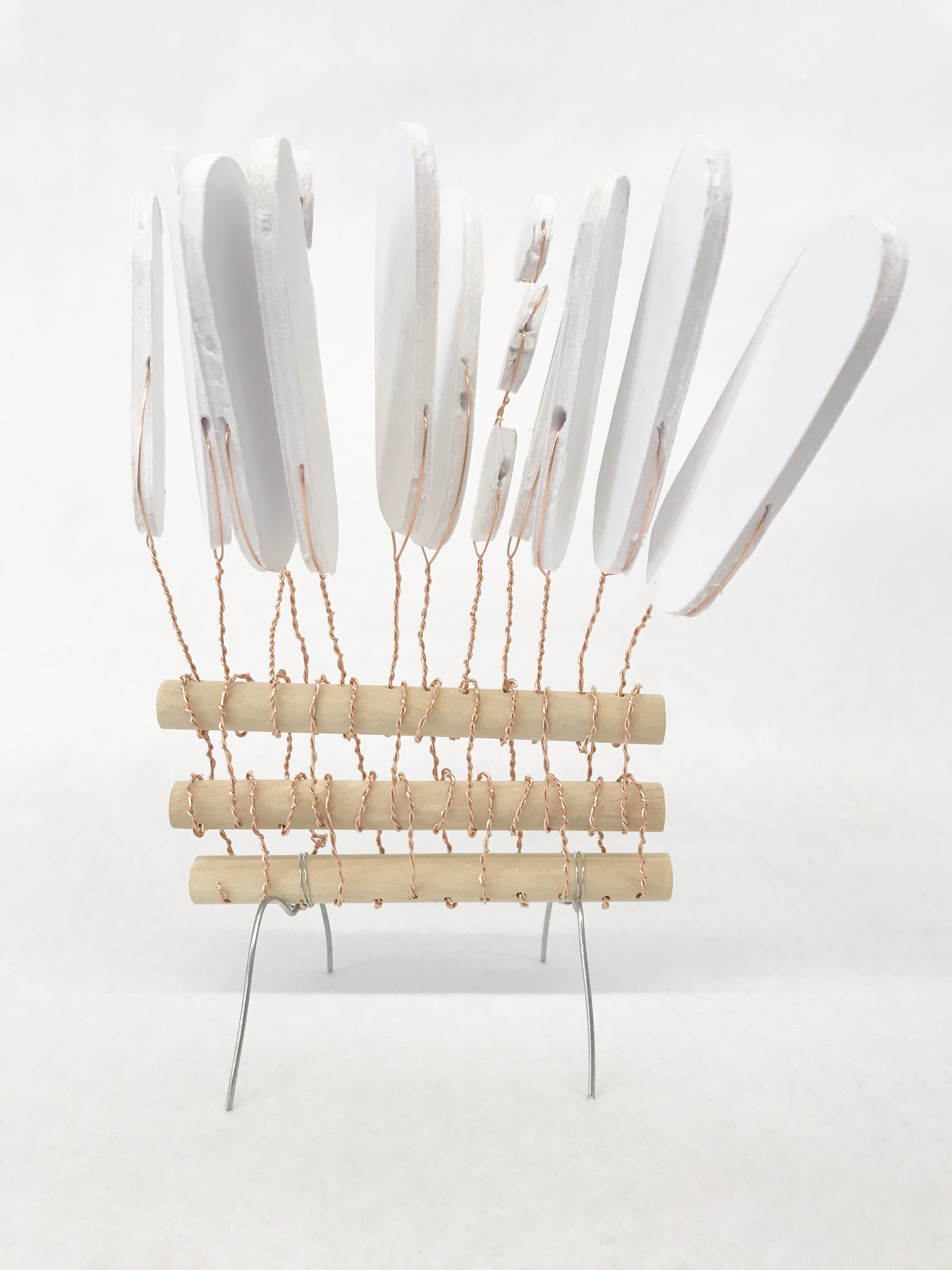- Name the exterior body part or section whose appearance you chose to reference in your project and explain how you identify with it as an important part of your body image.
- The body part I chose is my hand. I feel like as an artist, hands are very important tools in translating ideas from your mind onto a piece of paper, a canvas, and into a sculpture. I can’t imagine my life without my hands. I can’t imagine not being able to do what I love.
- Which one of the eleven body systems did you reference in your project? Explain how that one system especially supports, regulates, or structures the body part you named above, and describe how your project references the structure and forms comprising that system.
- I referenced the skeletal system in my project. The skeletal supports the hand, giving it its basic shape and allows movement. My project was inspired by the fingers and bones. Many of the foam core pieces extending from the dowels are in the basic shape of a finger, while two are referencing the bones. The dowels in my project are referencing the more stable bones located in the palm.
- Name the linear material(s) and planar material(s) you used and explain how you used wood.
- The linear material I used is copper 24 gauge wire and aluminum 16 gauge wire. The planar material I used is foam core. I also used three wooden dowels at the center of my piece, which support my piece as a whole.
- How do your materials themselves support both the structure and ideas you want to communicate about your body image?
- I chose foam core because they kind of resemble the layers in bones. The outer layer of bone is compact bone, which is like the paper, at the center is spongy bone, which reminded me of the foam. I chose wooden dowels, which like bones, are sturdy and supportive. I chose wire because like ligaments, allow the joints to bend and move. Through these materials, I wanted to show the strength and the mobility of the hand and fingers, which is not always apparent at first glance.
- What are the lines and planes doing in your sculpture? What are they doing to space? What are they doing to other lines and/or planes? (Hint: use verbs, and consider how these verbs relate to the functions of the body part/system you chose!)
- The planes in the sculpture are meant to reference fingers and the lines support the planes, holding them up and allow movement. Instead of creating five fingers, I made twelve instead. I wanted to created implied movement. Through repetition and the bending of the wire, I tried to mimic the back and forth motion of fingers. The fingers extend through the space, creating a fan-like motion.
- What kinds of joints and connections did you use? Explain how the connections not only do a physical job, but also form meaningful connections between materials conceptually.
- To connect the foam core pieces to the dowels, I looked at ligaments to see how the hold together bones. From this I used wire and looped them through the center of each foam core finger. I then twisted the two ends into a single long piece of wire and then weaved each one through holes I made in the wooden dowels. I chose to use wire because I want the fingers to be bendable, as well as give the whole piece a bit of movement.
- Reflect on the craftsmanship of your work: (how) were you able to create a 3D structure that supports itself effectively, and is meant to be viewed in the round? Describe on one area where your craft is particularly strong and one thing that could be improved.
- I think that as a whole, the project supports itself effectively. The wires hold the wooden dowels in place, while in turn the wooden dowels hold up the wire and the foam core fingers up in space. The project is indeed meant to be viewed in the round. The front and the back of the sculpture are the same, however from the side the viewer will get a different perspective. The strongest part of my piece would have to be the portion where the wires weave through the wooden dowels. As I had said before, both the wires and the wooden dowels support each other. An improvement I would make is strengthening the legs of the piece, which hold the whole thing up. I feel that they are much too delicate and are in need of re-enforcement.
- List the skills you learned or developed while making your project (materials, tools, techniques).
- Tools I learned to properly use include the drill, which I used to drill holes into the dowel, and the hand saw, which I used to divide the dowel into several pieces. I also learned to properly sketch my ideas and turn them into maquettes, which I can then translate into a final piece. Finally, I learned how to complete and clean up my final project through sanding.
- Discuss a way in which you’ve used one of the principles of design to organize the design of your piece and unify it as a composition (economy, balance, rhythm, contrast, emphasis, variety, unity) > OR < Discuss how you were inspired or influenced by one or more of the artists listed on your project sheet.
- An artist I was influenced by is Alexander Calder. I was inspired by his use of planes and lines in his work. Many of his sculptures have flat shapes connected to linear materials. They extend outward. From this idea I created the fingers in my hand.
Haptic Space and Materiality: Body Image Abstraction
- Posted on: March 7, 2018
- By: jeona532
- With: 0 Comments



